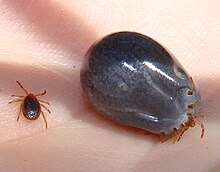User:Mr. Ibrahem/Tick paralysis
| Tick paralysis | |
|---|---|
 | |
| Australian paralysis tick before and after feeding | |
| Specialty | Emergency medicine |
| Symptoms | Tiredness, poor ability to walk, muscle weakness[1] |
| Complications | Respiratory failure[1] |
| Usual onset | 2 to 7 days with an attached tick[2][1] |
| Duration | Until a few hours to days after removal[1] |
| Causes | Certain types of tick bites[1] |
| Diagnostic method | Thorough examination[1] |
| Differential diagnosis | Guillain-Barre syndrome, botulism, poliomyelitis, myasthenia gravis, hypokalemia[1][3] |
| Treatment | Supportive care, removing the tick[1] |
| Prognosis | Good with treatment[1] |
| Frequency | Rare[3] |
Tick paralysis is a neurological condition that begins with tiredness, and progresses to poor ability to walk and muscle weakness as a result of certain tick bites.[1] Weakness starts in the legs and moves up the body.[1] Fever and rash do not generally occur.[1] Onset generally requires the tick to be attached for two to seven days.[1][2] Complications can include respiratory failure.[1]
While more than 40 types of type ticks are implicated, in North America the American dog tick and Rocky Mountain wood tick are most commonly involved while in Australia it is the Australian paralysis tick.[1] The underlying mechanism involves neurotoxin produced in female tick's salivary gland.[1] Diagnosis is by a thorough examination to find the tick.[1] It is a type of tick-borne illness.[1]
Treatment involves supportive care and removing the tick.[1] Supportive care may include mechanical ventilation.[1] Prevention is by avoiding tick bites such as by applying permethrin to clothing and using DEET.[1] Full recovery occurs within a few hours to days of the ticks removal.[1]
Tick paralysis is rare.[3] Cases, when they do occur, are most frequent in North America and Australia.[1] Children are more commonly affected than adults.[1] The condition was first described in the 1800s.[1] Other animals may also be affected.[1]
References[edit]
- ^ a b c d e f g h i j k l m n o p q r s t u v w x y z Simon, LV; West, B; McKinney, WP (January 2022). "Tick Paralysis". PMID 29262244.
{{cite journal}}: Cite journal requires|journal=(help) - ^ a b Pecina, CA (November 2012). "Tick paralysis". Seminars in neurology. 32 (5): 531–2. doi:10.1055/s-0033-1334474. PMID 23677663.
- ^ a b c "Tick Paralysis - Injuries; Poisoning". Merck Manuals Professional Edition. Archived from the original on 30 October 2021. Retrieved 13 July 2022.
